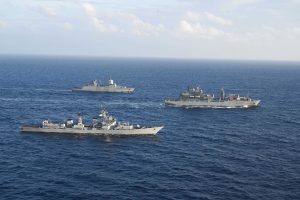In May 2024, the Indian Navy’s Eastern Fleet completed a series of “goodwill visits” to Singapore, Vietnam, Malaysia, Philippines and Brunei. As part of the Operational Deployment to the South China Sea, the Indian Navy visited these Southeast Asian countries and demonstrated its intent and efforts to deepen its growing network of maritime partnerships. Similar visits have been made for several years now.
According to the Indian Navy, “Naval diplomacy entails the use of naval forces in support of foreign policy objectives to build ‘bridges of friendship’ and strengthen international cooperation, on one hand, and to signal capability and intent to deter potential adversaries, on the other.” Apart from its military, constabulary, and benign roles, New Delhi utilizes its navy as a vital diplomatic tool in advancing its national interests and promoting its foreign policy objectives, both within and outside maritime spaces. Further, “strengthening political relations and goodwill” remains a key objective with respect to this diplomatic role. In this regard, overseas deployments and port visits are major tasks undertaken by the Indian Navy.
Commander P.K. Ghosh asserts that goodwill visits by the Indian Navy to ports in friendly maritime nations are a key aspect of India’s foreign policy. While these visits are largely ceremonial and part of peacetime operations, they play a significant role in strengthening maritime cooperation and conveying strategic signals to both allies and potential adversaries. Scholar Barry Blechman said, “The mere presence of a naval force in a region serves a political function, regardless of its composition, its mission, or its activity and even in the absence of any diplomatic activity directed towards similar ends. As such, a state that establishes a peacetime naval presence in a specific region is apt to gain influence in the affairs of that region.”
Even though New Delhi has been sending its naval warships on goodwill visits to countries all over the world since independence, its focus has primarily shifted to ports in the Indo-Pacific region in recent years.
In recent years, Indian naval ships from the Eastern Fleet have been actively engaged in goodwill visits to friendly countries across the Indo-Pacific. For example, in 2023 alone, the Indian Navy made port calls to Cambodia, New Zealand, and Papua New Guinea. However, these visits are not merely routine gestures to strengthen diplomatic ties; as mentioned earlier, they often serve to convey subtle strategic messages, particularly to China. The timing of these deployments is significant. The Indian Navy’s extended operational presence in the South China Sea, during heightened tensions between China and the Philippines, and its port calls in countries embroiled in maritime disputes with China, are far from coincidental.
Since relations between India and China worsened following the 2020 border clashes, India has increasingly positioned itself as a counterbalance to China’s assertiveness in the Indo-Pacific. New Delhi has not hesitated to deploy naval assets to the South China Sea, demonstrating a policy shift. In 2021, the Indian Navy conducted exercises with Australia, Indonesia, Malaysia, the Philippines, and Vietnam in the region. By 2023, it participated in a joint exercise with seven ASEAN navies in the South China Sea, followed by a joint statement with the Philippines calling on China to respect international law regarding its territorial claims. The latest deployment reflects the continuity of this strategic shift.
Similarly, the South Pacific has become another area of strategic competition between New Delhi and Beijing. China has significantly expanded its influence over Pacific Island nations, emerging as a key security and economic player in the region. Although India has primarily acted as a development partner to these nations, it is now aiming to strengthen its engagement. This was evident when, following the third Forum for India-Pacific Island Cooperation (FIPIC) Summit, two Indian Navy ships made a goodwill visit to Port Moresby, Papua New Guinea, signaling India’s intent to deepen ties in the region.
In conclusion, the Indian Navy’s goodwill visits to Southeast Asia and the broader Indo-Pacific region play a crucial role in advancing New Delhi’s foreign policy objectives through naval diplomacy. These visits not only strengthen India’s maritime partnerships but also serve as a strategic tool to project influence, signaling both cooperation with allies and a subtle deterrent to rivals, particularly China. By making these port calls and participating in joint exercises, India is positioning itself as a key player in the Indo-Pacific, reinforcing its commitment to regional stability, and a peaceful, rules-based order in the Indo-Pacific.
































